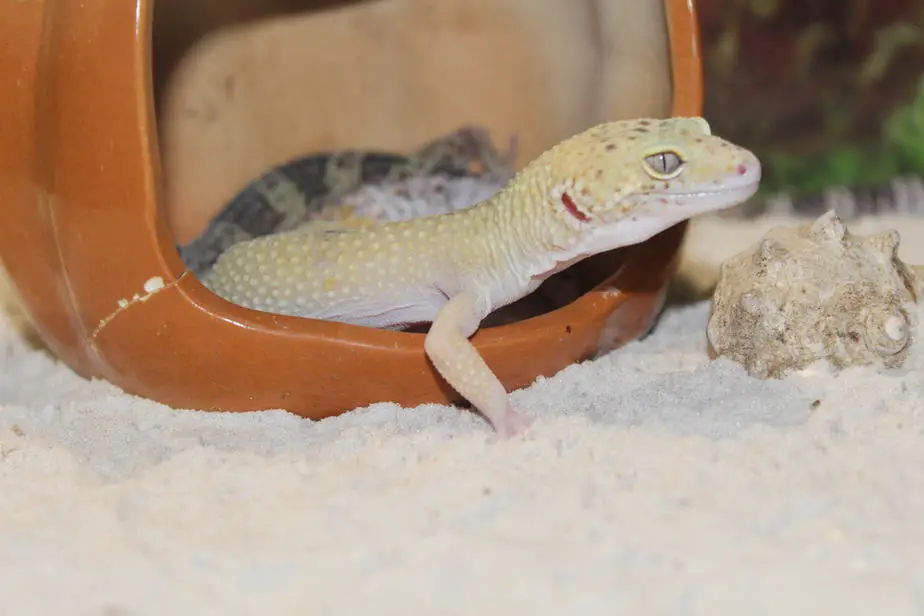Choosing the right tank size for a leopard gecko can be tricky, especially if it’s your first time keeping one of these reptiles. So, can your leopard gecko live in a 5-gallon tank? Well, that’s what we’re going to talk about today.
A leopard gecko can’t comfortably live in a 5-gallon tank, no matter how small they are. Even baby leopard geckos can’t live comfortably in a 5-gallon tank. The smallest size tank your gecko can live in is 10 gallons.

What’s the ideal tank size for a leopard gecko?
The ideal tank size for a leopard gecko is between 20 and 30 gallons. Smaller tanks of 10 to 19 gallons, while comfortable for baby geckos and juveniles, won’t be big enough to accommodate them throughout their lives.
So even if you get a high-quality 10-gallon tank, you’ll have to replace it when your leopard gecko gets too big for it. On the other hand, if you get a tank that is bigger than 30 gallons, your leopard gecko can get confused and disoriented, especially if they live alone in the tank.
They may even struggle with essentials like water, food, and hides within the tank. Ideally, you should only get such large tanks if you have more than one leopard gecko in the tank.
See our best leopard gecko tanks.
What is the ideal tank size for two or more leopard geckos?
The ideal tank size for two leopard geckos in 40 gallons. I generally recommend at least 20 gallons per leopard gecko.
There is one thing you need to keep in mind, though – housing two or more leopard geckos in the same tank is usually a bad idea, no matter how big the enclosure is.
This is because leopard geckos tend to be territorial and can try to dominate each other. This behavior is particularly common among male geckos, especially when there is one who is significantly smaller than the other.
It’s important to note that female and baby leopard geckos can also display this behavior. Ultimately, housing two or more leopard geckos together can lead to fights involving tail biting.
Do the dimensions of your leopard gecko’s tank matter?
Apart from its capacity, the dimensions of your leopard gecko’s tank also matter. This is because leopard geckos need more horizontal than vertical space, particularly because they are terrestrial animals. So to ensure that your leopard gecko’s space needs are met, ensure that the height of the tank is at least 30 cm (12 inches) and its floor space is at least 3 feet squared.
Fortunately, most 20-gallon reptile tanks fulfill these requirements. Their heights are usually 30 cm long, 60 cm (24 inches), and their widths are 45cm (18 inches). If you can find a tank that is 36 inches long and 45 inches in both width and height, this will be even more comfortable for your leopard gecko. Such tanks usually have enough space to place bowls, hiding spots, and humid hides while still providing enough space to roam around.
Ultimately, this ensures that your leopard gecko gets enough exercise and doesn’t get obese. This is particularly important because people don’t take their leopard geckos outside to walk and work out as they do for dogs and other pets.
What will happen if you consistently house your leopard gecko in a small tank?
Consistently housing your leopard gecko in a small vivarium can lead to serious health and behavior changes. For instance, it can make shedding harder for your gecko, leaving them with pieces of skin on their toes and limbs.
Also, you may notice that your leopard gecko is more aggressive and keeps barking and hissing. You may even notice that they constantly pace or stay away from their heat sources altogether. In extreme cases, your gecko’s growth can even get stunted.
Does the shape of your leopard gecko’s tank matter?
While it may not seem important, the shape of your leopard gecko’s tank does matter. Generally, the best shape for these tanks is rectangular. Their lengths make it easier for you to maintain an optimum thermal gradient in your gecko’s tank. Ultimately, this enables your leopard gecko to thermoregulate easily.
Should your leopard gecko’s tank have ventilation holes?
No matter what size of your leopard gecko’s tank, it needs to have some ventilation. Commonly, this is done by installing a mesh screen on the top of the tank. This is usually enough to provide adequate airflow and ensure optimum humidity levels in the tank. However, you can improve things by adding ventilation holes to the tank’s walls. Just remember to cover them with fine mesh.
These vents are particularly useful in balancing humidity levels in the tank. So when the humidity level goes above 40%, you can open the holes. And when the levels go below 30%, you can cover some of them.
Which is the best opening for your leopard gecko’s tank?
Generally, a leopard gecko’s tank should have two openings – a front one and a top mesh one. This ensures that you can get your leopard gecko in and out of the tank without having to move headlamps and other overhead accessories out of the way.
It’s also more comfortable for your leopard gecko to use because they can see you coming and won’t be surprised when you eventually scoop them up. Just keep in mind that sliding doors are better for leopard geckos than hinged ones.
Conclusion
Ultimately, a 5-gallon tank is way too small for any leopard gecko, even a baby. As such, it’s always best to start with a 20-gallon one. As long as you ensure that it’s rectangular, well-ventilated, and has a suitable shape, you and your leopard gecko will be fine.
